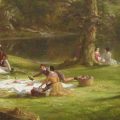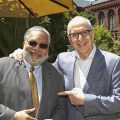Live from New York, the 2013 Spring All-Staff Meeting!
May is the 34th Asian Pacific American Heritage Month, and the Smithsonian is celebrating all month long with a variety of activities, performances, films, and workshops. To kick it off, “I Want the Wide American Earth: An Asian Pacific American Story” opened with a six-week showing at the National Museum of American History that will run through June 18. It will become a traveling exhibition, opening at the Japanese American National Museum in Los Angeles in September and eventually embarking on a 13-city tour.
Douglas Owsley, the Division Head for Physical Anthropology at the National Museum of Natural History, proved that survival cannibalism took place in historic Jamestown based on forensic analysis of 17th-century human remains.
Starting in May and continuing through July, the Cooper-Hewitt, National Design Museum is presenting the Harlem Focus programming series highlighting designers, architects, and artists whose work engages and affects the local Harlem community.
Winners were announced for the 10th annual Smithsonian magazine photo contest. The competition received more than 37,600 photo submissions this year from photographers hailing from 112 countries.
SEQUESTRATION
The Smithsonian did its best to anticipate sequestration—a 5 percent reduction to our federal budget, which amounts to about $42 million from March through September 2013. We made reductions to save money, including:
- Instituted a hiring freeze
- Restricted discretionary staff travel and training
- Cut funds for facility maintenance and new equipment purchases
- Reduced investments for research, education, and outreach
- Reduced funds for contractors
However, once the full impact of sequestration was clear, more tough decisions needed to be made for the remainder of fiscal year 2013 (through Sept. 30). In response to the ongoing funding cuts, the Smithsonian:
- Closed some exhibit areas due to a reduction in contract personnel. All museums remain open, and no major exhibitions are closed, but these three locations are closed because of sequestration: the Castle Commons; a small room in the National Museum of African Art’s permanent exhibition “African Mosaic”; and some sections of the permanent-collection galleries on the third floor of the Hirshhorn Museum and Sculpture Garden
- Slowed the process of digitizing our collections
- Reduced some research capacity
FEBRUARY
Smithsonian Books commemorated Charles Darwin’s birthday Feb. 12 with the release of the graphic novel, Darwin: A Graphic Biography.
Smithsonian Enterprises and Gale Cengage signed a licensing agreement to create searchable databases that will make more than 40 years of Smithsonian magazine, 30 years of Air & Space magazine, and an assortment of Smithsonian’s archival collections available digitally to the library and academic markets.
MARCH
The Cyrus Cylinder, a barrel-shaped clay object covered in the ancient Babylonian writing known as cuneiform, made its U.S. debut at the Arthur M. Sackler Gallery, appearing from March 9 through April 28.
Our National Collections Program held the two-day “Summit on the Museum Preservation Environment” in March. The program included internal and external experts discussing current thinking and best practices for environmental management and the need for sustainable approaches and interdisciplinary collaboration and decision making.
The National Portrait Gallery held the third Outwin Boochever Portrait Competition and exhibition, a chance for artists to explore the art of portraiture using a variety of media. Winners were announced in March, and the exhibition is on view through Feb. 23, 2014.
Warner Bros. Chairman Barry Meyer presented more than 30 Hollywood movie artifacts to the National Museum of American History, including props from the films Charlie and the Chocolate Factory, Batman and Robin and Corpse Bride.
APRIL
The Smithsonian announced a collaboration with Internet2, an advanced computer network connecting 220 U.S. universities, 60 corporations, 70 government agencies, 38 regional and state education networks, and more than 100 national research and education networking partners.
Smithsonian Libraries partnered with the Digital Public Library of America to provide links to the Smithsonian’s cultural and scientific content. The DPLA pilot project launched April 18 in Boston and combines and centralizes links to collections of participating cultural institutions. The Biodiversity Heritage Library will be a digital content hub for DPLA.
The National Museum of African Art’s “Earth Matters: Land as Material and Metaphor in the Arts of Africa,” opened in the museum and in Smithsonian Gardens. This installation of approximately 100 artworks examines the relationship between African artists and the land that informs and inspires the art, and will run through Jan. 5, 2014.
The National Air and Space Museum opened “Time and Navigation: The Untold Story of Getting from Here to There,” an exhibition exploring the relationship between timekeeping innovations and the ability for people to better navigate the world. This project is a collaboration between NASM and the National Museum of American History.
The National Museum of American History helped identify Alexander Graham Bell’s voice for the first time, using high-resolution optical scans to convert a wax-disc recording in the museum’s collection into an audio file. NMAH also marked the 12th annual Jazz Appreciation Month with a gift of jazz artifacts from the National Endowment for the Arts Jazz Master Randy Weston and Latin jazz drummer Horacio “El Negro” Hernandez. A financial gift from the Ella Fitzgerald Charitable Foundation also established the first endowment fund to support JAM, a monthlong celebration advancing appreciation of jazz as America’s original music.
“Grand Procession: Dolls from the Charles and Valerie Diker Collection,” an exhibition of handmade dolls featuring traditional attire of Plains and Plateau tribes, opened at the National Museum of the American Indian. The exhibition is on view through Jan. 5, 2014.
The National Museum of the American Indian named the Director’s Terrace in honor of the late Senator Daniel Inouye of Hawaii.
Watch the webcast of the May 15 All-Staff meeting featuring Alan Chu of Smithsonian Enterprises interviewing Secretary Clough and Caroline Payson of the Cooper Hewitt, National Design Museum discussing the Harlem Focus program that will reach more than 19,000 children. The webcast is on PRISM in the Secretary’s Corner under All-Staff Meetings webcasts.
Posted: 17 May 2013
-
Categories:
Administrative News , Feature Stories , News & Announcements










